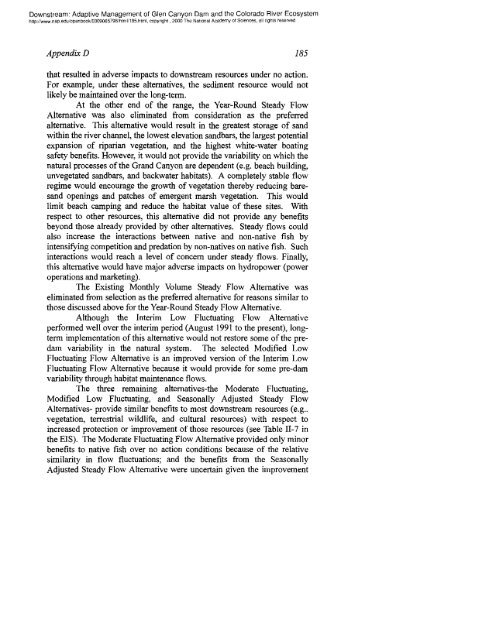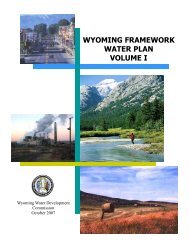Glen Canyon Dam adaptive management program. - Living Rivers
Glen Canyon Dam adaptive management program. - Living Rivers
Glen Canyon Dam adaptive management program. - Living Rivers
You also want an ePaper? Increase the reach of your titles
YUMPU automatically turns print PDFs into web optimized ePapers that Google loves.
Downstream: Adaptive Management of <strong>Glen</strong> <strong>Canyon</strong> <strong>Dam</strong> and the Colorado River Ecosystem<br />
http://www nap.edu/openbook/0309065798/html/185.html, copyright, 2000 The National Academy of Sciences, all rights reserved<br />
Appendix D 185<br />
that resulted in adverse impacts to downstream resources under no action.<br />
For example, under these alternatives, the sediment resource would not<br />
likely be maintained over the long-term.<br />
At the other end of the range, the Year-Round Steady Flow<br />
Alternative was also eliminated from consideration as the preferred<br />
alternative. This alternative would result in the greatest storage of sand<br />
within the river channel, the lowest elevation sandbars, the largest potential<br />
expansion of riparian vegetation, and the highest white-water boating<br />
safety benefits. However, it would not provide the variability on which the<br />
natural processes of the Grand <strong>Canyon</strong> are dependent (e.g. beach building,<br />
unvegetated sandbars, and backwater habitats). A completely stable flow<br />
regime would encourage the growth of vegetation thereby reducing baresand<br />
openings and patches of emergent marsh vegetation. This would<br />
limit beach camping and reduce the habitat value of these sites. With<br />
respect to other resources, this alternative did not provide any benefits<br />
beyond those already provided by other alternatives. Steady flows could<br />
also increase the interactions between native and non-native fish by<br />
intensifying competition and predation by non-natives on native fish. Such<br />
interactions would reach a level of concern under steady flows. Finally,<br />
this alternative would have major adverse impacts on hydropower (power<br />
operations and marketing).<br />
The Existing Monthly Volume Steady Flow Alternative was<br />
eliminated from selection as the preferred alternative for reasons similar to<br />
those discussed above for the Year-Round Steady Flow Alternative.<br />
Although the Interim Low Fluctuating Flow Alternative<br />
performed well over the interim period (August 1991 to the present), longterm<br />
implementation of this alternative would not restore some of the predam<br />
variability in the natural system. The selected Modified Low<br />
Fluctuating Flow Alternative is an improved version of the Interim Low<br />
Fluctuating Flow Alternative because it would provide for some pre-dam<br />
variability through habitat maintenance flows.<br />
The three remaining alternatives-the Moderate Fluctuating,<br />
Modified Low Fluctuating, and Seasonally Adjusted Steady Flow<br />
Alternatives- provide similar benefits to most downstream resources (e.g..<br />
vegetation, terrestrial wildlife, and cultural resources) with respect to<br />
increased protection or improvement of those resources (see Table 11-7 in<br />
the EIS). The Moderate Fluctuating Flow Alternative provided only minor<br />
benefits to native fish over no action conditions because of the relative<br />
similarity in flow fluctuations; and the benefits from the Seasonally<br />
Adjusted Steady Flow Alternative were uncertain given the improvement
















